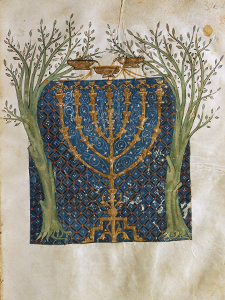The trees went to anoint a king over them: and they said to the olive tree: Reign thou over us
And it answered: Can I leave my fatness, which both gods and men make use of, to come to be promoted among the trees????Judges 9: 8-9, Douay-Rheims Bible
Olive oil provided fuel for sanctuary lamps throughout the Mediterranean world in antiquity and the Middle Ages, as well as holy oils for religious purposes. Above, left: A menorah flanked by two olive trees, as depicted in the Cervera Bible, recently on view at the Main Building. The brimming vessels?? used to fill the lamp appear at the top of the menorah. Right: A fifth-century standing lamp decorated with a cross; bronze lamps of this type were common in the early Byzantine world.
The olive was held to be the first of trees in both classical and biblical antiquity, prized above even the grapevine and the fig. A gift of the goddess Athena, the sacred olive symbolized the arts of peace and prosperity; the ruthless destruction of an enemy’s olive groves in wartime was held to be sacrilegious act. The Roman natural historian Pliny, writing in the first century A.D., attests that Athena’s olive was still venerated on the Athenian acropolis in his day (Historia naturalis, XVI 239???40). Although slow to bear, the tree is very long lived, surviving for hundreds of years. (The SpiceLines blog features an illustrated post about a Spanish olive estimated to be eighteen hundred years old.)
The tree, its fruits, and the oil pressed from them are both fundamental to and emblematic of Mediterranean culture. Equated with life and prosperity, the olive provided food, medicine, a skin cleanser and cosmetic, a lubricant, and a fuel, as well as an oil for religious unction. Olives are still a crop plant of the first economic importance; major producers include Spain, Italy, Turkey, Greece, Tunisia, Morocco, and the U.S. (California). Three-quarters of the world crop is produced within the European Union, mostly by Spain and Italy.
According to food historian Alan Davidson, the fruit of the wild olive, or oleaster, had been gathered by Neolithic peoples as early as 10,000 B.C. The wild tree was probably brought into cultivation in the Near East about 3000 B.C., and olive culture spread to Crete, Greece, Italy, Southern France, and Spain in the following three millennia.
The fatty berry of the olive, classified botanically as a drupe, yields oil when the fruit is pressed, but it also contains a bitter glucoside. This bitter principle must be removed from table olives, but it separates out naturally from the oil produced when the fruits are pressed.
This thirteenth-century enameled box from the Limoges region of France is thought to have once contained holy oils, such as the chrism used sacramentally in the rites of baptism, confirmation, and holy orders. The liturgical use of holy oils, including the anointing of kings, was inherited from Judaism.
The olive had healing properties of its own, but the oil was also used as a base for medicinal ointments and perfumed unguents throughout the Middle Ages. Hildegard of Bingen??affirms the??curative??powers of the olive tree:??she recommends boiling its bark and leaves and mixing the water with old fat to treat pains in the limbs, or??adding????olive water to a plaster to be laid on the belly to warm a cold stomach. Although southern European sources like the Tacuinum Sanitatis praise olive oil as easily digestible, this German abbess demurs: “The oil of the fruit of this tree is not much good for eating. If eaten, it provokes nausea and makes some foods troublesome to eat” (Physica, XVI). Hildegard goes on to extol the usefulness of olive oil in many medicaments, especially when cooked with roses or violets. (For more on Hildegard of Bingen, see “Mutter Natur,” October 15, 2010.)
???Deirdre Larkin
Sources:
Arano, Luisa Cogliati. The Medieval Health Handbook: Tacuinum Sanitatis. New York: George Braziller, 1976.
Davidson, Alan. The Oxford Companion to Food. Oxford: Oxford University Press, 1999.
Hildegard von Bingen. Physica. Translated by Priscilla Throop. Rochester, VT: Healing Arts Press, 1998.
Leclercq, Henri. “Holy Oils.” The Catholic Encyclopedia. Vol. 7. New York: Robert Appleton Company, 1910.
Moldenke, Harold N. and Alma L. Moldenke. Plants of the Bible. Waltham, MA: 1952. Reprinted. New York: Dover Publications, 1986.
Pliny. Natural History, Vol. IV, Books XIII???XVI. Translated by H. Rackham. Cambridge, MA: Loeb Classical Library, 1945, reprinted 1960.
Tags: chrism, drupe, glucoside, Hildegard of Bingen, Mediterranean, oil, oleaster, olive, Physica, Pliny, Tacuinum Sanitatis



